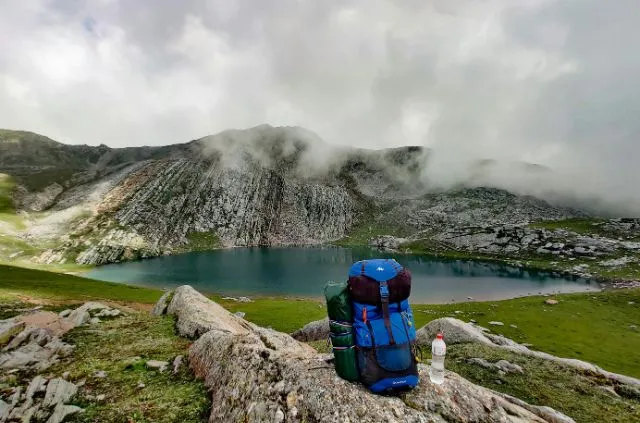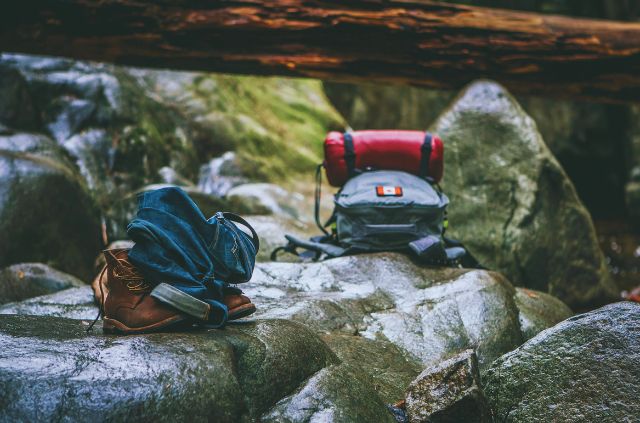Hiking is one of the best ways to get a good workout while staying connected with nature and is shown to increase serotonin levels in the brain while decreasing symptoms of stress and anxiety. Whether you’re hiking alone or spending a day on the trail with your friends and family, hiking is one of the best things that you can do for both your physical and mental health.
Before you reach the trailhead, you’ll need to select a trail that suits your fitness level, learn some basic hiking terms, and gather the necessary gear. You don’t have to be a top athlete to start hiking, but to stay safe and, most importantly, have a great time, choose a trail that fits your fitness level. If you rarely exercise, opt for a trail with minimal elevation gain. However, if you have a physically demanding job, play sports, or work out regularly, an easy or moderate trail should be manageable for you. For tackling a trail labeled ‘hard,’ some prior hiking experience is recommended.
The Bureau of Land Management (BLM), National Park Service, and Forest Service offer some of the world’s top hiking trails open to the public. They often design and maintain easier trails across the US that cater to families with young kids, novice hikers, and those who prefer a less strenuous trek to reach a scenic spot.
How to Plan and Prepare for Your Hiking Trip

Start with preparing for your trip and read our travel quotes to get some inspiration. If you are going for a hiking trip in your car, make sure you keep the essential car accessories along with the gear we have mentioned below.
1. Pack Appropriately
When determining what to pack, think about the length of the hike you are taking and the amount of time you will be gone. If you are going on a longer or more intense hike, you will be required to bring more gear. For a shorter hike, be sure to bring the appropriate amount of food and water – bring a little more than you think you need, even if you aren’t planning on being gone long. It’s better to be safe than sorry. Also, bring the navigation device of your choice, preferably a paper map or tech device that doesn’t require strong service. These are among the top essentials to bring while hiking Plus, pack rain gear and a light jacket if you are hiking in the colder months, as well as safety gear like band-aids and antibiotic ointment.
2. Wear Comfortable Clothing
To stay comfortable during a hike and to avoid injuries, wear clothing and shoes that fit properly, be sure you’re wearing clothing and shoes that fit properly and are appropriate for the conditions of a hike. Make sure you wear weather-appropriate clothing that will resist moisture such as sweat. Also, be sure to wear shoes that will support your feet throughout a long hike, while protecting your feet and toes from outdoor elements.
There following are common clothing types people generally wear when hiking

- Comfortable Tops: Sun hoodies, jackets, short-sleeved t-shirts, warm base layers, etc.
- Bottoms: Full-length pants, shorts, rain pants, etc.
- Travel accessories for hiking: Bandana, sun hats, sunscreens, sunglasses, etc.
3. Stretch!
Hiking promotes physical activity and makes the body active. But, it can put a considerable amount of stress on your body that you might not feel until later.
To avoid injury or discomfort during or after a hike, do a good amount of stretching before and after a hike, focusing especially on your leg and back muscles.
4. Pick the Suitable Trail
If you are a beginner in hiking, it is the best option to pick a hiking trail that is easy to climb. Ensure that the weather is pleasant and that there is no chance of snowfall, rain, or extreme temperatures. Plus, always know the estimated time, distance, and elevation of the trail to get an idea of how long it will take you to reach the destination.
5. Pick the Right Footwear
Since hiking is all about walking and climbing, you must have sturdy and durable shoes. They should be comfortable, breathable, and easy to wear. There are different types of footwear for different routes.
For example, trail running shoes are best for short and easy hikes. On the other hand, hiking sandals are best for trails with water streams or extremely hot weather. Moreover, you have to choose the right pair of socks to protect your feet from dust, dirt, pebbles, and insects.
6. Environmental Awareness:
While out on a hike, you might have come across the phrase ‘Leave No Trace‘ and wondered about its meaning. This saying is essentially about showing respect for nature and doing your part to protect the environment—think of it as the outdoor version of “Take only pictures, leave only memories.” Whether you’re actively doing something or choosing not to, it’s important to honor the trail and your fellow hikers. In simple terms, that involves:
- Avoid littering, even with natural items like fruit peels.
- Stick to the designated trail.
- Refrain from disturbing the natural surroundings (such as breaking branches).
- Be mindful of others on the trail (keeping noise levels low, etc.)
7. Navigation Skills:
Even if you’re sticking to well-marked trails, having some basic navigation skills can boost your confidence. Learning how to read a map and use a compass is a great start. Consider taking a beginner navigation class, available both locally and online. If you plan to explore more remote areas, you’ll want to get familiar with reading a topo map.
8. Essential Gear and Safety
Here’s a list of essentials I suggest for a day hike of moderate length:
- Backpack
- First aid kit (a preassembled kit is a convenient choice—it saves you from having to put one together yourself. I also like to include medications suited to the season, such as antihistamines for spring and summer outings)
- Maps, guidebooks, a compass, and a GPS system
- Hiking clothes
- Hiking boots/shoes/sandals (choose what suits you best)
- Trekking poles (optional)
- Water (the amount needed depends on the hike)
- Snacks
Always leave your itinerary with someone trustworthy and register at trailheads to provide vital information in case of emergencies.
9. Hiking with children and furry friends
Kids:
Hiking with children can be magical. Little ones, even in baby carriers, can join, while older kids can explore on their own.
Tips:
- Keep them dry, warm, and fed.
- Choose short trails, stopping often to enjoy the nature around you.
Dogs:
Got a furry buddy? Make sure they’re allowed where you’re going. National parks mostly prohibit dogs, even on leashes, but many state parks are dog-friendly. Leashes, however, are almost always required.
Tips:
- Have your dog carry their food and water in a dog pack.
- Take breaks for snacks and hydration.
- Always pack out poop bags. Leaving bags on the trail for later is bad etiquette.
10. Handling wildlife, staying safe
Worried about animals? Attacks are rare and usually happen if a hiker startles one. Better safe than sorry, though.
Best advice: respect their space. If you spot a deer, bear, or bison up ahead, give it room. Wait for it to pass; patience keeps things calm.
In areas with bears, carrying bear spray (effective on other animals too) is smart. And if a bear’s around, the National Park Service has solid advice on staying safe.
Hiking with others? Great idea! Talking in a group can prevent encounters, and animals tend to avoid groups.
Look for these qualities in footwear before selecting it for hiking
- It should be stable and durable.
- It should be waterproof and breathable to keep the feet cool on a summer hiking trip.
- The design must be comfortable and lightweight.
- The boot must have enough cushioning to support your ankle.
- It should be according to the size and shape of your feet to ensure a good fit.
11. Easy Does It: Don’t Burn Out!
Look, it’s totally normal to feel pumped and want to zoom up the trail. But trust me, going out too fast is the quickest way to run out of steam and end up miserable. Hiking isn’t a race! Find a pace where you can actually breathe and maybe even chat a bit without gasping. And please, take breaks! Seriously, stop for a few minutes every so often. Drink some water before you’re parched, munch a snack, and actually look around. It’s way better to finish feeling good than to push too hard and regret it later. Your legs will thank you!
12. Be Cool on the Trail: Trail Manners 101
Think of the trail like a shared space. Just like on the road, there are little courtesies. The main one? Folks hiking uphill usually get the right of way. Why? ‘Cause stopping and starting again on a climb is tough work! So, if you’re heading down, just step aside for a sec and let them pass. Also, keep the noise down – no one really wants to hear your playlist echo through the woods. People are out there for peace and quiet. A simple nod or “hi” to people you pass is always nice, too. It just makes things friendly for everyone.
13. One Last Weather Peek: Seriously!
Yeah, you checked the weather app days ago. But nature, especially in the hills, loves to change its mind! What looked sunny on Monday could be showers by Saturday morning. So, right before you walk out the door, do a final, quick check of the forecast specifically for where you’re hiking. It takes two seconds and can be a game-changer. It tells you if you really need that rain jacket or maybe an extra warm layer. Better to know what you’re walking into, right?
14. Practice Makes Perfect: Start Near Home
Got big hiking dreams? Awesome! But maybe don’t make your first hike a massive mountain trek. Try out some short, easy trails near where you live first. Think of it like a test drive. You get to break in your boots (super important to avoid blisters!), see how your backpack feels with stuff in it, and figure out how much water you actually need. It’s a low-pressure way to get comfortable with your gear and build a little confidence before you tackle something bigger. In addition, you might uncover some unruffled native spots!
15. The “Just in Case” Message: Tell Someone Your Plan
Okay, this one’s super important, no kidding. Before any hike, tell someone reliable – a friend, family member, whoever – exactly where you’re going (the trail name!), roughly how long you think you’ll be, and when they should expect to hear from you that you’re back safe. If something goes wrong (like a twisted ankle or getting lost), this is your lifeline. If you don’t check in, they know who to call and where to send help. It sounds serious, but it’s a simple step that brings huge peace of mind. Do it every time!
Conclusion:
Hiking is one of the best things you can do for your body and mind, and is a relatively beginner-friendly sport. Even if you are a beginner, you can utilize these tips and tricks to fulfill your desire to hike. Make sure to select clothing and accessories that are suitable for your route because there are different attire and accessories for different trails. Do not stress over hiking or traveling, just pack your bags and start your journey.
Intro: Whether you’re hiking alone or taking your next group vacation with your friends and family, hiking is one of the best things that you can do for both your physical and mental health.



